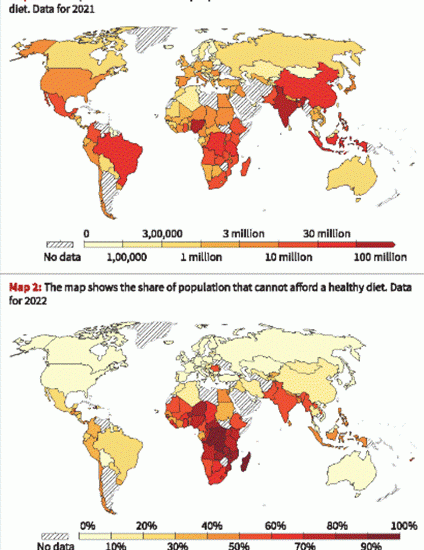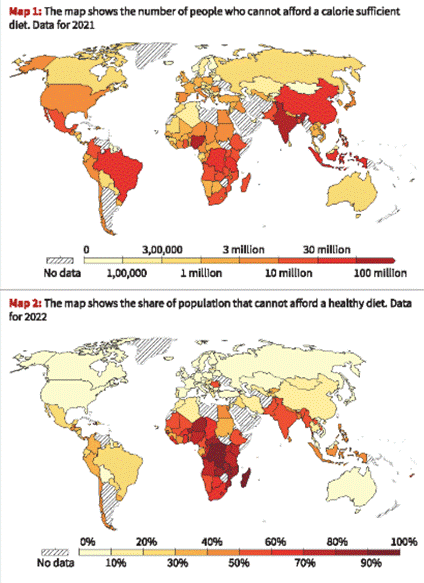
Three billion folks can not afford a nutritious diet
International Context of Vitamin Affordability
- A wholesome, nutritious food plan is 4x costlier than a primary calorie-sufficient one.
- 3 billion folks globally can not afford a nutritious diet — even when they spent most of their revenue on meals.
- 1.1 billion folks (14% of the worldwide inhabitants) can not even afford the most elementary energy-sufficient food plan (rice/maize solely).
Relevance : GS 2(Well being , Starvation , Poverty)
Hidden Starvation and Micronutrient Deficiency
- Billions endure from “hidden starvation” – deficiencies in iron, calcium, Vitamin A, iodine, and many others.
- A calorie-sufficient food plan (principally cereals and starches) lacks proteins, important fat, and micronutrients important for well being.

Financial & Structural Drivers
- The price of a nutritious diet globally averages $3.67/day, unaffordable for low-income populations.
- Subsistence farmers are additionally counted among the many undernourished — if they can’t produce or afford calorie/nutrient-sufficient diets.
- Weight loss program affordability is predicated on whole revenue minus non–meals important expenditures like housing and transport.
Regional Disparities
- In Sub-Saharan Africa, over 80% of the inhabitants can not afford a nutritious diet.
- In India, a nutritious diet prices almost as a lot because the median revenue, leaving no room for different bills.
- In distinction, folks in France or Denmark spend simply 5–6% of their revenue on meals — showcasing stark inequality.
Meals Tips vs Actuality
- Most international locations have Meals-Primarily based Dietary Tips (FBDGs) recommending a various consumption from all meals teams.
- However these tips are economically inaccessible to the poor in lots of areas.
- Researchers used regionally consultant tips — not imposing Western fashions universally.
Coverage Implications
- A calorie-sufficient food plan would possibly assist survival, however fails to make sure well being or human potential.
- Financial inequality, meals worth volatility, and low incomes should be tackled collectively.
- A sustainable answer should transcend calorie sufficiency — specializing in diet safety.
Key Takeaways
- Affordability of meals isn’t just about worth, however revenue and important non-food wants.
- Three billion folks lack the means to eat for long-term well being — a worldwide public well being disaster.
- Addressing this hole is crucial for reaching SDG 2: Zero Starvation and SDG 3: Good Well being and Nicely-Being.
India’s Authorities Initiatives :
1. Public Distribution System (PDS)
Supplies sponsored grains to round 800 million folks.
Fulfills calorie wants however lacks dietary range.
2. Pradhan Mantri Garib Kalyan Anna Yojana (PMGKAY)
Initially launched throughout COVID-19 totally free ration distribution.
Now a everlasting scheme beneath NFSA offering free foodgrains to PDS beneficiaries.
3. PM POSHAN (previously Mid-Day Meal Scheme)
Presents nutritious meals to high school youngsters.
Some states embody eggs, milk, or fruits.
4. Built-in Baby Growth Companies (ICDS)
By Anganwadi centres, gives supplementary diet, well being check-ups, and pre-school training for youngsters (0–6 years) and pregnant/lactating girls.
5. Nationwide Meals Safety Act (NFSA), 2013
Supplies authorized entitlement to five kg of foodgrains per particular person/month for precedence households.
Covers 75% of rural and 50% of city inhabitants.
6. POSHAN Abhiyaan (Nationwide Vitamin Mission)
Goals to cut back stunting, undernutrition, anaemia, and low delivery weight.
Makes use of expertise integration and real-time Poshan Tracker.
7. Anaemia Mukt Bharat (AMB)
Focuses on decreasing anaemia in youngsters, adolescents, and girls by way of IFA supplementation, deworming, and fortified meals.
8. Fortification Initiatives
Staples like rice, wheat, oil, milk, and salt fortified with iron, folic acid, Vitamin A & D.
Fortified rice being distributed by way of PDS, PM POSHAN, and ICDS.
Leave a Reply